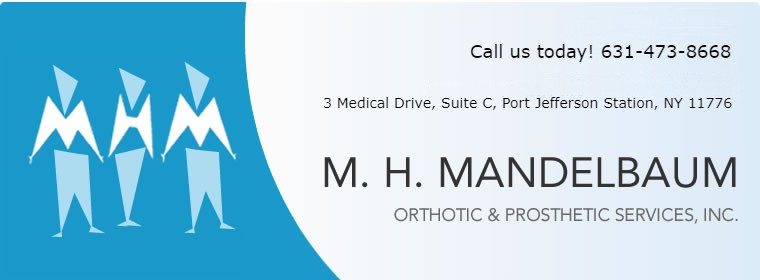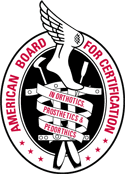As if the terms Orthotics and Prosthetics weren’t difficult enough to pronounce (even after many years of practice!) their meaning is often a mystery. Simply, an orthotic or orthosis, is a device (as a brace or splint) for supporting, immobilizing, or treating muscles, joints, or skeletal parts which are weak, ineffective, deformed, or injured. A prosthetic or prosthesis is an artificial device to replace or augment a missing or impaired part of the body. (i.e. limbs, eye, teeth or joints). It is a rewarding profession and in spite of our field’s anonymity we help thousands of patients nationwide. We hope to change that of course, sharing our world with you, the web, and the rest of the world. Part of uncovering the enigma is decoding the industry language. Fluency of our language will make you the visitor feel that much more welcome. So if it’s BK prosthesis, scoliosis jacket, or myoelectric don’t fret, just look it up in our glossary.
Glossary:
The name of the amputation is determined by the part of the limb removed. Most types or levels of amputation are referred to by letters or abbreviations. Here is a list of different types of amputations:
- A/E – above elbow
- A/K – above knee
- B/E- below elbow
- B/K – below knee
- Bilateral – both sides (leg or arm)
- Elbow Disarticulation- arm at elbow
- Forequarter- arm, shoulder, clavicle and scapula
- Hemipelvectomy- leg, hip and pelvis
- Hip Disarticulation- leg at hip
- Knee Disarticulation- leg at the knee
- Shoulder Disarticulation- arm at shoulder
- Transmetatarsal- toes and part of forefoot
- Wrist Disarticulation- hand at wrist
ABRASION: Wearing away of the skin through rubbing or friction.
AE: An above the elbow amputation.
AKA: An above the knee amputation.
ARCHITECTURAL BARRIER: Stairs, ramps, curbs or anything, which obstructs your walking or wheelchair mobility.
BE: A below the elbow amputation.
BILATERAL AMPUTEE: Refers to a person missing both arms or legs.
BKA: A below the knee amputation.
TEST SOCKET: A temporary socket, often transparent, made over the plaster model to aid in obtaining the proper fit.
CONTRACTURE: Tightening of muscles around a joint which restricts the range of motion.
DESENSITIZATION: The process of making the residual limb less sensitive to touch by massaging, tapping or using a vibrator.
DEFINITIVE PROSTHESIS: A replacement for a missing limb, which meets accepted standards for comfort, fit, alignment, function, appearance and durability.
EDEMA: A local or generalized condition in which the body tissues contain an excess of fluid.
ENDOSKELETAL PROSTHESIS: A prosthesis, which derives its strength from an internal structure (plyon). This design has a soft outer surface.
EXOSKELETAL PROSTHESIS: A prosthesis, which derives its strength from its outer structure, typically reinforced plastic. Heavier but more durable than endoskeletal.
GAIT TRAINING: Learning how to walk with your prosthesis or prostheses.
OCCUPATIONAL THERAPIST: A therapist who is concerned with teaching you how to perform activities of daily living such as feeding, grooming, bathing and dressing as independently as possible.
ORTHOSIS (BRACE): An external device applied to limit or assist motion of any given part of the human body.
ORTHOTIC: Pronunciation: or-‘th?tik, Function: noun, Etymology: New Latin orthosis
: a device (as a brace or splint) for supporting, immobilizing, or treating muscles, joints, or skeletal parts which are weak, ineffective, deformed, or injured
PARTIAL SUCTION: Usually refers to the socket of an above the knee prosthesis which has been modified to allow the wearing of prosthetic socks while wearing the prosthesis.
PHANTOM PAIN: Pain, which seems to originate in the portion of the limb, which was removed.
PHANTOM SENSATION: The normal ghost image of the absent limb may feel normal at times and at other times, be uncomfortable.
PHYSIATRIST: A doctor of Rehabilitation Medicine who specializes in the comprehensive management of patients with impairments and disabilities arising from neuromuscular, musculoskeletal, and vascular disorders.
PHYSICAL THERAPIST: A therapist who is concerned with your gross motor activities such as transfers, gait training, and how to function with or without a prosthesis.
PISTONING: Refers to the residual limb slipping up and down inside the prosthetic socket while walking.
PLY: Thickness of stump sock material. The higher the ply number the thicker the socket.
PROSTHESES: More than one prosthesis.
PROSTHESIS: an artificial device to replace or augment a missing or impaired part of the body. (i.e. limbs, eye, teeth or joints)
PROSTHETICS:PROSTHETICS: Pronunciation: -tiks, Function: noun plural but singular or plural in construction: the surgical or dental specialty concerned with the design, construction, and fitting of prostheses
PYLON: A rigid central shaft, usually tubular, that is attached to the socket or knee unit of an endoskeletal prosthesis. The lower end of the pylon should be connected to a foot ankle assembly. Also used to refer to a simple temporary prosthesis.
RANGE OF MOTION: The amount of movement a limb has in a specific direction at a specific joint such as your hip or knee.
REHABILITATION: The process of restoring a person who has been debilitated by a disease or injury to a functional life.
RESIDUAL LIMB: The portion of the arm of leg remaining after the amputation. Some people refer to it as a stump .
REVISION: Surgical modification of the residual limb.
SOCIAL WORKER: A professional who assists you by helping to coordinate your discharge from the hospital and oversees appropriate contact with other services or organizations. The social worker will help to facilitate your reentry into family and community life.
SOFT INSERT LINER: Cup shaped form, which fits inside the socket of a BK prosthesis.
SOFT SOCKET: Soft-liner built into a prosthetic socket to provide cushioning or permit muscle function.
THERAPEUTIC RECREATION: Provides instruction in returning to leisure activities.
TOTAL SUCTION SOCKET: This type of socket permits the prosthesis to be held on the residual limb by outside air pressure. May often eliminate straps and belts.
TRANSFERS: Moving from one position to another (such as from sitting on a bed to sitting in a wheelchair).
TRAUMATIC AMPUTATION: An amputation, which is the result of an injury.
info@mhmoandp.com |
3 Medical Drive, Suite C, Port Jefferson Station, NY 11776 / Phone: 631-473-8668

